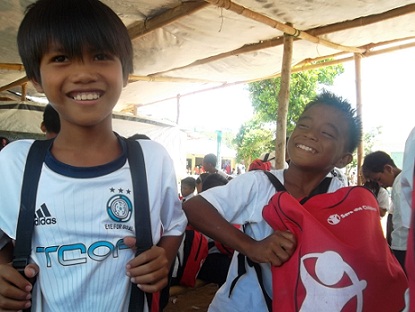By ALFRED JOHN TAYONA and HAZEL P. VILLA
Photos by ALFRED JOHN TAYONA

Perched on top of a hill in Islas de Gigantes, one and half hours pump boat ride away from the mainland of Carles in northern Iloilo, a school ravaged by super typhoon Yolanda (International name: Haiyan) struggles to educate students despite roofless classrooms, lack of books and chairs.
Mabelle Mortel, 26, a third grade teacher at Lantangan Elementary School, recalls that Monday before Yolanda smashed into Carles on Nov. 8, 2013, they were excited to hold their classes in the newly repaired classroom.
When Yolanda left, it brought with it the roof of Mortel’s classroom. Her charts and other visual aids were all destroyed and the students’ books were all wet. The same was true with the other schools in the Islas de Gigantes group of islands.
At the opening of classes early this month, Mortel’s classroom remained roofless. She holds her classes under a makeshift classroom with no desks, no chairs and no books for her 54 students.
With a total of 1,144 students, Lantangan Elementary School has the biggest student population in the District of Carles, higher than the schools in the mainland.

Ten classes are held under makeshift classrooms, one class is held in a stage and nine other classes are held in classrooms have yet to be repaired.
Beside Lantangan Elementary School, nine more classrooms are being constructed and while some of the rooms already have roofs, they do not have walls to protect the children when the rainy season starts.
In spite of these circumstances, children are excited to go to school.
Wilben Joy Argonsola, a fourth grade student says it is fine with her to study without a regular classroom as long as she is able to learn.
The youngest of four of a fisherman and a sari-sari store owner, Wilben dreams of becoming a teacher.
In an English textbook, English being one of her favorite subjects, Wilben read about the story of a sunflower named Mary Sunflower, narrating that the sunflower died because nobody watered it. In that story, Wilben learned that sunflowers need care so they will not die.
Wilben Joy, would have loved to read more stories from her English textbook but the only book that the class has belongs to her teacher.

Like Wilben, 9-year-old Rady dela Fuente, does not mind sitting on a bamboo pole nailed from side to side under the makeshift classroom.
His father catches crabs and sells it in the market while his mother stays at home. He dreams of becoming a police man so he could protect his family.
Grade six student, Jamel Pagayunan , 12, wants to be a seafarer.
“Okay lang nga ga klase kami sa dalum tent kay eskwelahan man ni gyapon (It’s okay to study under the tent because this is still considered a school),” says Jamel, who is fond of shadow drawing.
Early this month, Save the Children, a non-government organization, distributed starter kits-bags containing school supplies to more than a thousand students as incentive for children to remain in school and learn.
The organization has also partnered with the Department of Education and the local government unit to ensure that families with children, who are most in need, are taken care of. After emergency relief operations, the organization now shifts focus on helping the typhoon survivors rebuild their lives.





